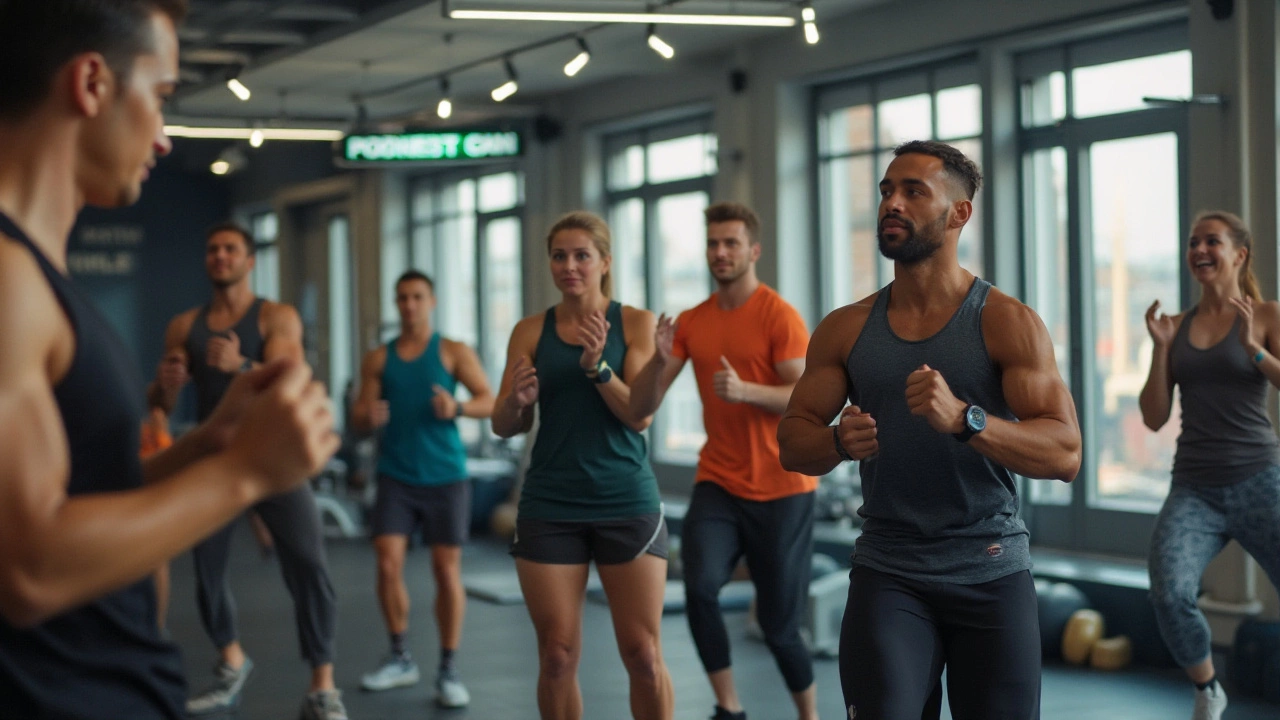
High-Intensity Interval Training, commonly known as HIIT, seemingly promises a quick route to fitness in our busy lives. It's this allure of efficiency—a full workout in under 30 minutes—that draws many to HIIT. However, like all fitness regimes, it's important to glance behind the curtain and recognize possible downsides.
If you're not careful, the intense nature of these sessions can edge you towards injuries, particularly if your form falters amidst the rapid pace. There's also the hurdle of accessibility; beginners might find the regimen daunting, posing a barrier to their introduction to regular exercise. And, as with many things in life, too much HIIT can tip scales into overtraining territory, impacting not just your body but also your mood and motivation.
So, as we dive into these lesser-known aspects of HIIT, let us equip ourselves with insights that can help balance intensity with well-being, keeping your fitness journey both effective and sustainable.
High-Intensity Interval Training, or HIIT training, has revolutionized the fitness world with its promise of delivering maximum benefits in minimal time. At its core, HIIT alternates between short bursts of intense activity and brief periods of rest or low-intensity recovery. It's not just an exercise but a strategic approach to building endurance, burning calories, and enhancing aerobic and anaerobic systems. This method is so appealing because it challenges both the body and mind, pushing them to adapt quickly.
The origins of HIIT can be traced back to the 1970s with a greater spotlight shed onto it in the early 2000s as it gained traction among elite athletes and fitness enthusiasts. It primarily targets cardiovascular health, leveraging intensity to push your heart rate to about 80-95% of its maximum, something that traditional steady-state cardio doesn't offer. This method is compelling due to its efficiency—delivering similar or superior benefits in less time. Some studies indicate that 27 minutes of HIIT workouts three times a week produce similar aerobic and anaerobic gains as five days of an hour-long endurance training.
However, HIIT is not a one-size-fits-all package. The intensity level can vary greatly, from sprinting and cycling to more simplified versions that involve basic bodyweight movements like jump squats and burpees. Experts often highlight the versatility as one of the key strengths of HIIT. This adaptability allows people to personalize workouts to their fitness level and specific goals. Dr. Martin Gibala, a HIIT researcher, has been quoted saying,
"The beauty of HIIT is that you can tailor it to fit your personal needs, whether you are an elite athlete or an older adult trying to get back in shape."
Along with its popularity, certain disadvantages associated with HIIT have emerged, primarily due to its demanding nature. The prevalent risks include injuries from improper form or lack of adequate recovery time. And then, there's the mental component—while some thrive under the pressure of intense intervals, others may find it discouraging or overwhelming. Thus, understanding and acknowledging these potential setbacks is as crucial as grasping its benefits.
In essence, while HIIT offers a fruitful path to fitness with its high returns and versatile nature, it's also a double-edged sword. Taking the time to educate oneself about its full spectrum—from benefits to limitations—ensures a safer and more sustainable engagement with this popular exercise form.
Engaging in HIIT training pushes participants to the upper limits of their physical abilities, where the margin for error is unfortunately thin. The rapid pace and repetitive high-intensity movements increase the likelihood of sustaining injuries, especially for those who might not have flawless technique. Common injuries associated with HIIT include muscle strains, sprained ankles, and even more severe issues like knee injuries. The inherent risk lies in the dynamic exercises that HIIT often involves, such as burpees, high knees, or box jumps, which can be particularly taxing on joints if performed incorrectly or without adequate strength and flexibility preparation.
For individuals who are new to HIIT workouts, maintaining proper form throughout the high-octane routines can be exceptionally challenging. Fatigue can set in quickly during intervals, which can lead to diminished concentration and form, both of which are vital in preventing injury. It's like running a car engine on maximum power repeatedly without checks—something's bound to give if it's not handled carefully. Though HIIT is designed to accommodate different fitness levels, newcomers might underestimate the needed modifications or fail to recognize their body's limits.
According to a study published in 2022, about 30% of HIIT participants reported experiencing some form of injury within the first year of starting. The nature of these injuries was predominantly musculoskeletal, which emphasizes the need for proper warm-up routines and cross-training to build resilience.
"Injury prevention should be a critical component of any HIIT program," notes Dr. Rachel Kim, a renowned sports physician, emphasizing the integration of flexibility and strength training into one's routine.Ignoring warnings like discomfort or lurking pain can transform small annoyances into chronic setbacks, reminding us that listening to our bodies is crucial.
Ensuring adequate recovery time is another vital aspect of reducing the risk of injury in HIIT. Without proper rest, the body's muscle fibers, tendons, and ligaments don't get the chance to recuperate and strengthen between workouts. The temptation to dive into sessions back-to-back can stem from an earnest desire for quick results, but it can inadvertently lead to injury due to accumulated fatigue. A balanced schedule that incorporates rest days or active recovery can help in safeguarding against overuse injuries. Incorporating strength training and stretching sessions can herald not just improved performance but a more sustainable fitness journey.
To aid in safer training, paying attention to the choice of footwear and exercise surfaces is crucial. Good shoes designed for high-impact workouts can provide necessary support and cushioning, thereby guarding against impact-related injuries. Likewise, choosing indoor flooring that can absorb shock can also help in reducing stress on joints, particularly during exercises that involve jumping. Both equipment and environment play pivotal roles in fostering a safer HIIT experience. Emphasizing the importance of these might seem basic but they constitute foundational elements of injury prevention in high-intensity workouts.
Lastly, ensuring expert supervision, particularly during the initial phases of embracing HIIT, can offer invaluable guidance. Professionals can provide personalized adjustments, correct form, and offer insights into injury prevention tailored to individual fitness backgrounds. Whether through group fitness classes led by certified trainers or personalized sessions, having trained eyes during these dynamic routines can be crucial. This combines with technology; wearable fitness trackers that monitor form and heart rate can be excellent tools to alert users of potentially dangerous fatigue levels, thus preempting mishaps.

Embarking on a fitness journey with HIIT training might seem exciting, given its promise of high results in less time. However, for beginners, this enthusiasm could be laced with challenges. Although HIIT sessions are touted for their efficiency, they often assume a level of fitness and familiarity with exercise that's not always present in those new to working out. This can lead to not just physical strain but also mental overwhelm. Newcomers might struggle to maintain proper form, leading to a higher risk of injury and discouragement early on.
HIIT workouts typically demand maximal exertion, with minimal rest between high-intensity movements, which can be daunting for those just starting their fitness regime. It's crucial to approach these workouts with caution, gradually increasing intensity as the body adapts. A step-by-step progression, rather than jumping straight into a full-blown HIIT session, can help mitigate the risk of injuries and make the workout more accommodating. For instance, initial sessions might focus on learning the movements correctly before even considering the speed or rest intervals. This can help bridge the gap between sedentary lifestyles and these intense workouts.
"Starting HIIT without proper physical preparedness can lead to unnecessary injuries and reduce motivation," says Dr. Jane Simmons, a renowned sports medicine expert. "It’s about understanding your body's limits and gradually building up to the demands of such high-intensity sessions."
Furthermore, understanding one's limitation can empower beginners. Listening to one's body is paramount, especially when mixing various exercises with swift transitions. Using small steps can assure safety without sacrificing the gains. Many experts recommend supplementing HIIT with lower-intensity activities, such as walking or yoga, to help build a solid fitness foundation. These activities enhance cardiovascular endurance without the overwhelming stress that often comes with HIIT.
A beginner's approach could involve structured training with a professional or knowledgeable mentor who can guide the friendlier aspects of these workouts while reinforcing the importance of rest and recovery. Allowing the body to adequately recover is integral to avoiding burnout. Building a reliable routine that makes room for rest, proper nutrition, and adequate hydration ensures a balanced approach to fitness without the steep pitfalls of starting too far off one's personal limits.
When engaged in the pursuit of sculpting a fitter body through HIIT workouts, it's crucial to recognize the fine line between challenging the body and outright overtraining. Many fitness enthusiasts, eager to witness swift results from their high-intensity routines, can inadvertently plunge headfirst into a cycle of doing too much too often. Overtraining syndrome may rear its head quite insidiously, manifesting in signs such as constant fatigue, decreased performance, and even emotional disturbances. The allure of quick progress sometimes eclipses the awareness of these symptoms, leading individuals to push themselves past productive thresholds.
In a world that often glorifies 'no pain, no gain', it's easy for fitness newcomers to overlook the recuperative requirements of such demanding exercise regimes. The body's need for rest and repair post-HIIT is not merely a recommendation but a necessary aspect of the process. Muscles, stressed under the rigors of repeated high-intensity sessions, demand time to recuperate to avoid strain-related injuries or chronic fatigue, which can ultimately derail one's fitness aspirations. Rest days, though sometimes underestimated, form the critical contrast required to achieve sustainable progress.
"The human body is like a finely-tuned machine; it demands a meticulously balanced blend of stress and recovery to function optimally," renowned strength coach Mike Mahler once stated.
Additionally, evidence suggests that ignoring signs of overtraining can amplify stress hormone levels such as cortisol, negatively affecting metabolic processes including the immune response and appetite control. These biochemical shifts not only threaten to sabotage the physical efforts made during workouts but can also tamper with one's mood and motivation. The persistent eagerness to cut down on rest or forego proper nutritional intake can further exacerbate these challenges, presenting a complex puzzle in one's journey towards health.
To better handle the risk of overtraining within the context of HIIT training, consider implementing structured changes within your routine. Ensuring a minimum of one to two rest days in a week dedicated to recovery could protect against the detrimental cycle of overexertion. Emphasizing a balanced diet rich in proteins and anti-inflammatory foods helps invigorate your body's replenishing capabilities. It’s a constructive practice to listen to your body's cues and adjust your routine in response to how it feels, promoting a healthier relationship with your workout habits.
A sensible approach towards HIIT incorporates the appropriate intensity without neglecting recuperation. By achieving this balance, you set the stage for enduring fitness success without the looming specter of burnout. An ongoing dialogue between ambition and caution serves as the key to harnessing the utmost benefits of your exercise endeavors while protecting your well-being from the pitfalls of overtraining.

When we discuss fitness, it’s not just about the physical benefits. Our mental state, though silent in its expression during intense exercise like HIIT training, has a story to tell, often missed amidst the clamor of endorphin high-fives. High-Intensity Interval Training is admired for its speed and efficiency, but the mental demands of these sessions can sometimes outweigh the physical. This intense approach to exercise can ignite stress responses, especially if the frequency of workouts leaves little room for recovery. With heart rates soaring and sweat pouring, the body’s pressure cooker environment might churn up feelings of anxiety rather than releasing them.
The swift transitions in HIIT from high effort to rest don’t only challenge muscles but also test mental resilience, making it easy for feelings of pressure and inadequacy to bubble up if a session feels unsuccessful. Imagine getting trapped in a cycle where you’re chasing the clock rather than your personal best, which can lead to a shift in mindset where exercise feels less like joy and more like a ticking box. Some enthusiasts might find themselves on a psychological treadmill where the thrill of progress overshadows listening to their body’s need for rest.
"Physical activity is great for mental health, but it’s important to find a balance," says Dr. Harry Brandt, a psychiatrist specializing in exercise behavior. "Too much intensity without adequate recovery can in fact contribute to stress and fatigue rather than alleviate it."
On a structural note, studies show that HIIT can have variable effects on mood. For instance, a research study published in the Journal of Sports Science showed that while there’s a short-term boost in mood right after a session, the intense demand could lead to irritability and tension if repeated too often without proper recovery. This isn’t to suggest abandoning HIIT altogether but understanding its role in a balanced fitness regime is crucial. Incorporating periods of mindfulness and actual rest, switching gears between high-intensity days and low-impact activities can create a harmonious blend of physical and mental stimulation. Here’s how one might mark this balance:
Thus, as much as workout risks rigmarole the thoughts, a tailored approach is always the best fit. Fitness is personal, and so is mental wellbeing; each take should be tailor-made to fit like a glove, absorbing the brisk winds of high spirits and resting comfortably in the calm of understanding oneself holistically.
Finding the right balance between intensity and recovery is not just a challenge; it's an art that many HIIT enthusiasts grapple with. With the rigorous nature of HIIT pushing your limits, it's easy to overlook the importance of recovery, potentially leading to burnout. This balance is crucial because the benefits of HIIT truly blossom when your body is allowed to rest and repair. Over-looking this aspect can lead to diminishing returns, where you find yourself gassed but not gaining the benefits you once did.
Recovery isn't just about resting your muscles after those high-power intervals; it's about replenishing your energy stores and reducing mental fatigue. Studies have shown that incorporating rest can significantly enhance overall performance and increase workout efficiency. The National Academy of Sports Medicine suggests that active recovery can improve circulation and help eliminate metabolic waste, fostering a more effective recovery process.
"The key to sustainable HIIT success is not just how hard you push during workouts, but how well you rest afterward," says Dr. Alan Goodwin, a well-respected exercise scientist.
Understanding how to integrate recovery into your routine involves a few key practices. Start by listening to your body; it communicates through soreness, fatigue, and sometimes a complete lack of energy. Treat these signals with respect. Implement active recovery days, such as yoga or light stretching, to keep your body moving without the intense impact. You can also span out your HIIT sessions, targeting different muscle groups to allow others the opportunity to recuperate.
Nutritional support plays a vital role in this balance too. Consuming lean proteins, healthy fats, and plenty of hydration aids the body's repair. Intuitive eating can also guide how you replenish after workouts, prompting you to nourish your body with what it truly needs. Hydration should never be an afterthought; it is the fundamental catalyst for recovery and maintaining performance. Ensure you're drinking plenty of water throughout the day, not just around your workouts.
Exploring the correct ratio of workout to recovery is often personal and varies for each individual, depending on factors like fitness level, age, and frequency of HIIT sessions. A table from a recent survey among fitness enthusiasts reveals that most found an ideal interval of two intense days followed by a day of rest worked best.
| Workout Intensity | Recommended Recovery |
|---|---|
| High | 2-3 days |
| Medium | 1-2 days |
| Low | 0-1 days |
This isn't a one-size-fits-all; it's about experimenting and tuning in to your body's unique needs for recovery. Remember, treating recovery with the same significance as your HIIT sessions ensures that the hard work you put in truly pays off, keeping the scales of fitness in harmonious balance.